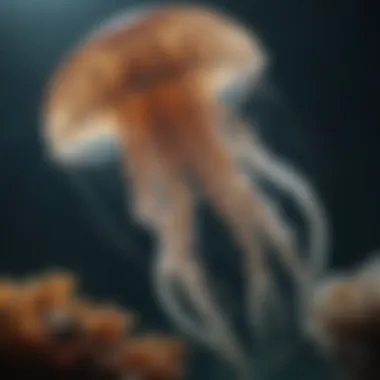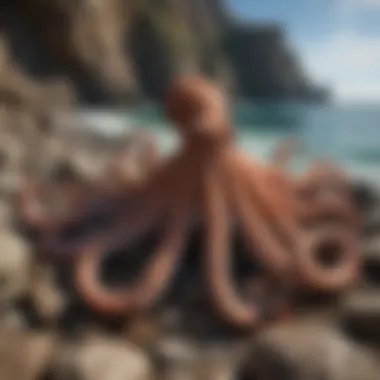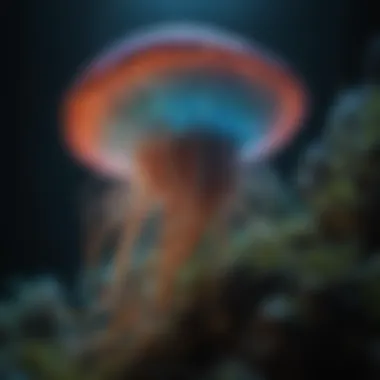Unraveling the Wonders of Sea Creatures: A Dive into Marine Mysteries


Rock and Fossil Identification
Delving into the mysterious realm of sea creatures often parallels the meticulous processes of rock and fossil identification. Just as geologists and paleontologists scrutinize stones and remnants from Earth's distant past, marine biologists meticulously analyze the unique features and behaviors of sea creatures to unlock the secrets of their existence. In this section, we will explore the parallels between these two seemingly divergent worlds and uncover the key characteristics that aid in the identification of marine life forms.
Types of Rocks and Fossils
While rocks and fossils are relics of the geological past, sea creatures are living snapshots of evolutionary history. The diversity of rocks and fossils mirrors the wide array of sea creatures populating the ocean depths. From sedimentary layers preserving ancient life forms to igneous rocks forged in fiery depths akin to the seafloor, each type of rock symbolizes a chapter in Earth's story. Similarly, fossils offer glimpses of long-extinct organisms, providing vital clues to understanding past ecosystems. By drawing parallels between these geological artifacts and present-day sea creatures, a deeper appreciation for the interconnectedness of Earth's history emerges.
Characteristics to Look for
Just as distinctive features aid in the identification of rocks and fossils, specific traits define various sea creatures. The textures and compositions of rocks parallel the unique anatomical structures of marine organisms, allowing experts to categorize and classify them effectively. Whether it's the intricate patterns on a rock's surface or the specialized appendages of a sea creature, attention to detail is paramount in distinguishing one specimen from another. Observing color variations, sizes, and patterns become essential aspects in uncovering the identity of these enigmatic entities.
Tools for Identification
To unravel the enigma of sea creature identification, scientists rely on a suite of specialized tools and technologies. Just as geologists use hammers and chisels to extract fossils from rocks, marine biologists utilize underwater cameras and sonar equipment to observe creatures in their natural habitat. Advanced imaging techniques and DNA analysis further aid in unraveling evolutionary relationships among different species. By employing cutting-edge tools in the study of marine life, researchers can dissect the intricate puzzle of sea creature identification with precision and accuracy.
Introduction
The Introduction sets the stage for unraveling the enigma of sea creatures in this article, playing a pivotal role in providing a comprehensive overview of the topic at hand. It serves as the gateway to a fascinating exploration of the intricate world of marine life, captivating the audience with a brief glimpse into the mysterious realm of sea creatures. By delving into the depths of the ocean, this article aims to shed light on the hidden wonders and complexities that define these remarkable organisms.
Unveiling the Mysteries
The allure of sea creatures
The allure of sea creatures is a mesmerizing aspect that draws in both scientists and enthusiasts alike. From the graceful movements of a jellyfish to the intricate patterns of a seahorse, the allure lies in their captivating beauty and unique adaptations for survival. This section will delve into the mesmerizing charm of sea creatures, highlighting how their allure plays a crucial role in shaping our understanding of the marine world.
Impact on marine ecosystems
The impact of sea creatures on marine ecosystems is profound and multifaceted. From providing vital services such as nutrient cycling to regulating predator-prey dynamics, sea creatures play a crucial role in maintaining the delicate balance of the ocean. By examining their impact on marine ecosystems, we will uncover the intricate web of relationships that governs life beneath the waves, showcasing the pivotal role that sea creatures play in sustaining the health of our oceans.
Diversity and Adaptations


Variety of sea creature species
The sheer variety of sea creature species is staggering, ranging from microscopic plankton to majestic whales. Each species brings its uniqueness to the marine ecosystem, contributing to the rich tapestry of life beneath the waves. This section will showcase the diversity of sea creature species, highlighting the incredible array of forms and functions that define the underwater world.
Unique adaptations for survival
Sea creatures have evolved a myriad of unique adaptations to survive in the challenging marine environment. From camouflage to bioluminescence, these adaptations offer a fascinating glimpse into the ingenuity of evolution. By exploring these unique adaptations for survival, we unravel the evolutionary puzzle that has shaped sea creatures into the diverse and resilient organisms we see today.
Anatomy and Physiology
Anatomy and Physiology play a crucial role in unraveling the enigma of sea creatures, offering a deep insight into the inner workings of these fascinating beings. The study of the anatomical structures and physiological processes of sea creatures provides a foundation for understanding their intricate design and functionality within their marine environment. By delving into the anatomy and physiology of sea creatures, we can uncover the evolutionary adaptations that have enabled them to thrive in diverse oceanic ecosystems, shedding light on their unique characteristics and biological mechanisms.
Structural Marvels
Specialized body parts
Specialized body parts in sea creatures are marvels of evolution, finely tuned to serve specific functions essential for survival in their aquatic habitats. These specialized structures, ranging from intricate appendages to sensory organs, exhibit remarkable adaptations that allow sea creatures to navigate their environment effectively. One of the key characteristics of specialized body parts is their heightened sensitivity to environmental cues, enabling sea creatures to respond swiftly to potential threats or opportunities for food. The unique feature of specialized body parts lies in their diversified forms across different species, showcasing the unparalleled diversity of adaptations in sea creatures. While advantageous in enhancing the survival prospects of sea creatures, these specialized body parts may also present limitations in certain contexts.
Defense mechanisms
Defense mechanisms in sea creatures play a vital role in safeguarding against predators and environmental hazards, showcasing a diverse range of adaptation strategies. These mechanisms, which can range from camouflage and toxins to physical deterrents, serve to protect sea creatures from harm and ensure their survival in a competitive marine ecosystem. The key characteristic of defense mechanisms lies in their effectiveness in deterring potential threats through mechanisms such as warning coloration or mimicry. The unique feature of defense mechanisms is their adaptability, with sea creatures evolving various defense strategies that best suit their specific ecological niche. While advantageous in providing protection, defense mechanisms can also come with disadvantages, such as energy expenditure or vulnerability to certain predator tactics.
Physiological Wonders
Respiration and circulation
The physiological aspects of respiration and circulation in sea creatures play a fundamental role in sustaining life functions, enabling efficient oxygen uptake and nutrient transport throughout their bodies. Sea creatures exhibit a diverse array of respiratory and circulatory adaptations tailored to their aquatic environment, optimizing oxygen exchange and waste removal. The key characteristic of respiration and circulation lies in their capacity to function effectively in varying environmental conditions, allowing sea creatures to thrive in a range of habitats. The unique feature of respiration and circulation is their adaptability to different levels of oxygen availability, showcasing the resilience of sea creatures in challenging marine environments. While advantageous in promoting survival, respiration and circulation mechanisms may have disadvantages related to energy expenditure or susceptibility to environmental stressors.
Sensory adaptations
Sensory adaptations in sea creatures are essential for detecting stimuli in their surroundings, aiding in navigation, communication, and foraging behaviors. These adaptations encompass specialized sensory organs that can perceive changes in light, pressure, temperature, and chemical cues, enhancing the sensory acuity of sea creatures. The key characteristic of sensory adaptations is their precision in detecting subtle environmental cues, allowing sea creatures to make informed decisions vital for survival. The unique feature of sensory adaptations lies in their ability to differentiate between various sensory stimuli with remarkable accuracy, highlighting the sophisticated sensory capabilities of sea creatures. While advantageous in enhancing sensory perception, sensory adaptations may pose disadvantages related to sensory overload or inaccuracies in processing complex stimuli.
Behavioral Patterns


In the intricate realm of sea creatures, understanding their behavioral patterns is paramount to unraveling the enigma they present. The study of these patterns provides crucial insights into how these creatures navigate their environments, interact with each other, and adapt to various circumstances. Behavioral patterns encompass a wide array of actions such as feeding strategies, reproductive behaviors, communication methods, and social structures. By dissecting and analyzing these patterns, researchers can gain a deeper understanding of the behavioral ecology of sea creatures and how their actions contribute to the overall marine ecosystem. Furthermore, delving into behavioral patterns offers a glimpse into the evolutionary processes that have shaped the behavior of these fascinating marine organisms. By exploring the intricate web of behaviors exhibited by sea creatures, we can unravel the complexities and marvels of their existence.
Feeding Strategies
Hunting Techniques
One of the primary components of sea creature behavioral patterns is their hunting techniques. This specific aspect plays a crucial role in their survival and success within the marine environment. Sea creatures have developed a diverse range of hunting techniques to capture prey efficiently. Whether it be stalking, ambush predation, or cooperative hunting, each technique has its own unique characteristics and advantages. Stalking, for instance, involves stealth and patience, allowing predators to approach their prey unnoticed. On the other hand, ambush predation relies on sudden and swift attacks to catch unsuspecting victims. The choice of hunting technique is influenced by various factors such as prey availability, habitat type, and individual predator capabilities. Understanding the nuances of different hunting techniques provides valuable insights into the predatory behaviors of sea creatures and the dynamics of predator-prey relationships.
Feeding Habits
Complementing hunting techniques, sea creatures exhibit a diverse array of feeding habits that contribute significantly to their survival and ecological roles. Feeding habits encompass the types of food consumed, feeding mechanisms employed, and feeding strategies adopted by different species. Some sea creatures are filter feeders, passively collecting food particles from the water column, while others are active predators that hunt and consume live prey. Additionally, scavengers play a crucial role in recycling nutrients within marine ecosystems by feeding on decaying organic matter. Each feeding habit is tailored to the specific ecological niche occupied by the sea creature, ensuring efficient energy acquisition and nutrient cycling. By exploring the unique features of feeding habits among sea creatures, we can appreciate the diversity of feeding strategies present in the marine environment and the intricacies of nutrient flow within ecosystems.
Reproductive Behaviors
Spawn Patterns
Reproductive behaviors are vital aspects of sea creature biology, shaping population dynamics, genetic diversity, and evolutionary processes. Spawn patterns, in particular, play a fundamental role in the reproductive strategies of many marine species. The timing, location, and method of spawning can vary significantly among different sea creatures, reflecting adaptations to specific environments and reproductive challenges. Some species engage in mass synchronized spawning events, where large numbers of individuals release gametes simultaneously to increase the chances of fertilization. Others have elaborate courtship rituals leading to selective mating and fertilization. Understanding spawn patterns provides valuable insights into the reproductive success and the reproductive ecology of marine organisms, shedding light on the intricacies of their life cycles and population sustainability.
Mating Rituals
In addition to spawn patterns, mating rituals represent another intriguing aspect of sea creature reproductive behaviors. Mating rituals encompass a wide range of displays, behaviors, and interactions aimed at attracting mates, establishing dominance hierarchies, and ensuring successful breeding. These rituals can range from elaborate dances and vocalizations to competitive displays and aggressive interactions. By studying mating rituals, researchers can unravel the complexities of mate selection, sexual competition, and mate fidelity within different sea creature species. Mating rituals play a critical role in shaping genetic diversity, population structure, and reproductive success, highlighting the importance of understanding the intricate behaviors associated with reproduction in marine environments.
Ecological Interactions
Importance of Ecological Interactions
In the comprehensive exploration of sea creatures unraveling, the section on Ecological Interactions shines a spotlight on the intricate web of relationships that underpin marine ecosystems. These interactions play a pivotal role in maintaining the delicate balance of the underwater world, highlighting the interconnectedness of various species and habitats. By delving into this topic, readers gain a profound understanding of how sea creatures rely on and influence one another, shaping the dynamic tapestry of ocean life.
Predator-Prey Dynamics
Ecosystem Balance


Within the realm of Predator-Prey Dynamics, the aspect of Ecosystem balance emerges as a critical force shaping the survival of sea creatures. This equilibrium ensures that predatory and prey species coexist harmoniously, preventing overpopulation or depletion of certain populations. The key characteristic of Ecosystem balance lies in its ability to sustain biodiversity and ecological stability, making it a fundamental concept in marine conservation efforts. While advantageous for maintaining a healthy ecosystem, challenges may arise when environmental changes disrupt this delicate balance, emphasizing the fragility of marine habitats.
Adaptations for Survival
Exploring further, the discussion on Adaptations for survival unveils the remarkable ways in which sea creatures have evolved to thrive in their environments. From camouflage to specialized hunting techniques, these adaptations serve as essential tools for survival in a competitive world. The distinctive feature of Adaptations for survival is their adaptive nature, allowing species to respond to environmental pressures and ensure their continued existence. While advantageous for species survival, adaptations may also pose limitations when environmental conditions undergo rapid changes, testing the resilience of marine organisms.
Symbiotic Relationships
Mutually Beneficial Partnerships
The exploration of Symbiotic Relationships delves into the mutualistic bonds that exist between different species in the marine world. These partnerships showcase how organisms rely on one another for survival, exchanging resources and services for shared benefits. The key characteristic of Mutually beneficial partnerships lies in the reciprocity and interdependence observed between species, highlighting the interconnected nature of marine life. While advantageous for promoting species resilience, such relationships can also be fragile, vulnerable to disruptions that impact the delicate balance of ecosystems.
Interconnectedness in the Ocean
Finally, the narrative on Interconnectedness in the ocean underscores the intricate relationships that transcend individual species boundaries. This interconnectedness emphasizes how events in one part of the ocean can have far-reaching effects on distant ecosystems, illustrating the unity of the marine world. The unique feature of Interconnectedness in the ocean lies in its ability to emphasize the global impact of local actions, fostering a sense of responsibility and stewardship towards protecting our oceans. While advantageous for promoting conservation awareness, this interconnectedness also highlights the vulnerability of marine environments to widespread environmental threats.
Conservation Challenges
In this pivotal section of the article, we delve into the critical aspect of Conservation Challenges. The conservation of sea creatures is of utmost importance due to their intrinsic role in maintaining the delicate balance of marine ecosystems. By shining a light on the various threats faced by these creatures, we aim to raise awareness and inspire action for their protection and preservation. Conservation Challenges encompass a spectrum of pressing issues that require immediate attention to safeguard the rich biodiversity of the oceans. From human impacts to the far-reaching consequences of climate change, the need for concerted conservation efforts has never been more urgent.
Threats to Sea Creatures
Human Impact
The detrimental effect of human activities on marine life is a central theme in the discussion of Conservation Challenges. Overfishing, pollution, habitat destruction, and bycatch are some of the key areas where human impact poses a significant threat to sea creatures. The depletion of fish stocks, contamination of waters with plastics and chemicals, and the destruction of coral reefs are direct consequences of human actions. While advancements in technology have enabled more efficient fishing practices, they have also led to widespread environmental degradation. Understanding the devastating impact of human activities is crucial in formulating strategies to mitigate these threats and ensure the sustainability of marine ecosystems.
Climate Change Consequences
Climate change represents a formidable challenge to the conservation of sea creatures. Rising sea temperatures, ocean acidification, and extreme weather events are altering marine habitats at an unprecedented rate. These changes disrupt the delicate balance of ecosystems, leading to shifts in species distributions, reduced reproductive success, and increased vulnerability to diseases. The warming of oceans accelerates coral bleaching, threatening the existence of delicate reef ecosystems. Adapting to these changing conditions requires adaptive management strategies and international cooperation to reduce greenhouse gas emissions and mitigate the impacts of climate change on marine biodiversity.
Protective Measures
Conservation Efforts
Efforts to conserve sea creatures encompass a wide range of initiatives aimed at promoting sustainable fishing practices, restoring damaged habitats, and enhancing public awareness. Marine protected areas, fisheries management plans, and community-based conservation projects play a crucial role in safeguarding vulnerable species and habitats. By fostering cooperation among governments, conservation organizations, and local communities, these efforts seek to strike a balance between human needs and the protection of marine biodiversity. Conservation efforts not only benefit sea creatures but also contribute to the overall health of marine ecosystems and the well-being of coastal communities.
Legal Protections
Legal protections serve as a vital tool in safeguarding sea creatures from exploitation and habitat degradation. International treaties, national regulations, and regional agreements provide a framework for the conservation and management of marine resources. By establishing guidelines for sustainable resource use, pollution control, and habitat preservation, legal protections help ensure the long-term survival of endangered species and vulnerable marine ecosystems. Enforcing compliance with these regulations is essential in addressing emerging threats and promoting conservation-minded practices among stakeholders. Effective legal frameworks are essential in harmonizing conservation efforts on a global scale and safeguarding the future of sea creatures.







